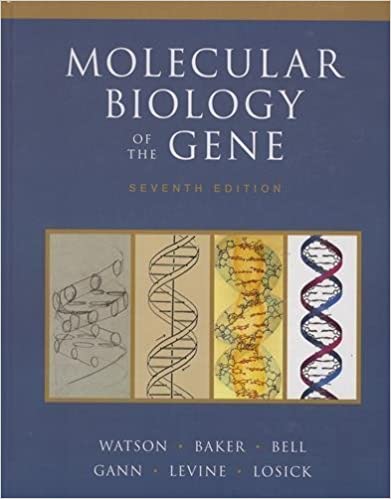
Molecular Biology of the Gene 7th Edition by Richard Losick, James Watson, Michael Levine, Tamara Baker, Alexander Gann
Edition 7ISBN: 9780321762436
Molecular Biology of the Gene 7th Edition by Richard Losick, James Watson, Michael Levine, Tamara Baker, Alexander Gann
Edition 7ISBN: 9780321762436 Exercise 1
Researchers studying ? repressor binding to the three binding sites in the right operator produced the data in the table below. In the experiment, they performed a DNase I protection assay (footprinting assay) using the DNA containing all three binding sites for a range of repressor concentrations From this, they calculated the relative concentration of repressor dimers required to occupy a specific binding site on half of the DNA molecules present (values given in table).

A. Based on the data for wild-type DNA and the information in Chapter 18, explain why the relative concentrations for O R1 and O R2 are almost the same despite the fact that O R1 has a 10-fold higher affinity for ? repressor than O R2 does (information from this chapter).
B. Based on the data for wild-type DNA and the information in Chapter 18, explain why the relative concentration of repressor needed to bind O R3 is much higher than for O R1 and O R 2.
C. Based on the data for mutant DNAs X and Y, identify the binding site ( O R1 , O R2 , or O R3 ) that included the mutation in each respective mutant. Explain your choices.
D. Given what you know from this chapter, explain why the relative repressor concentration required to bind O R3 goes down to 5 for Mutant X relative to wild-type DNA in terms of the mechanism for ? repressor binding DNA.

A. Based on the data for wild-type DNA and the information in Chapter 18, explain why the relative concentrations for O R1 and O R2 are almost the same despite the fact that O R1 has a 10-fold higher affinity for ? repressor than O R2 does (information from this chapter).
B. Based on the data for wild-type DNA and the information in Chapter 18, explain why the relative concentration of repressor needed to bind O R3 is much higher than for O R1 and O R 2.
C. Based on the data for mutant DNAs X and Y, identify the binding site ( O R1 , O R2 , or O R3 ) that included the mutation in each respective mutant. Explain your choices.
D. Given what you know from this chapter, explain why the relative repressor concentration required to bind O R3 goes down to 5 for Mutant X relative to wild-type DNA in terms of the mechanism for ? repressor binding DNA.
Explanation
A.Binding is reliant on the affinity to ...
Molecular Biology of the Gene 7th Edition by Richard Losick, James Watson, Michael Levine, Tamara Baker, Alexander Gann
Why don’t you like this exercise?
Other Minimum 8 character and maximum 255 character
Character 255


